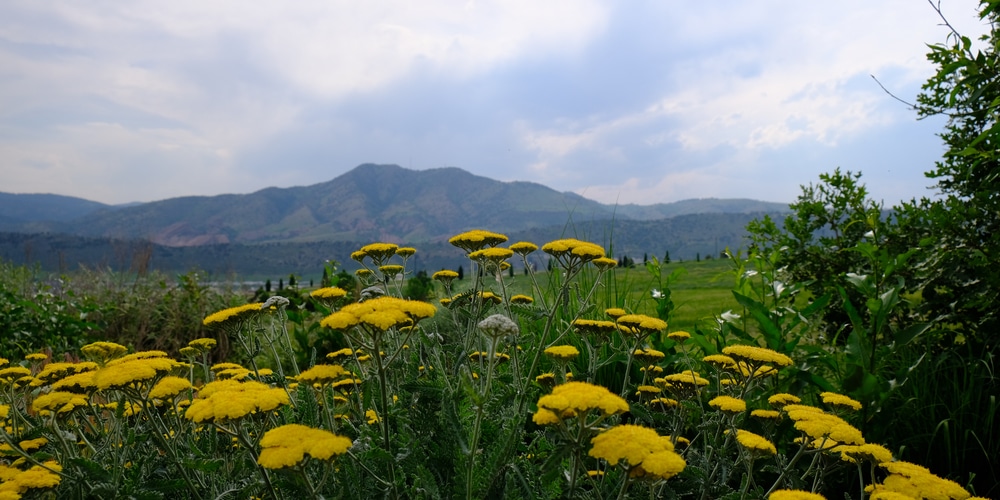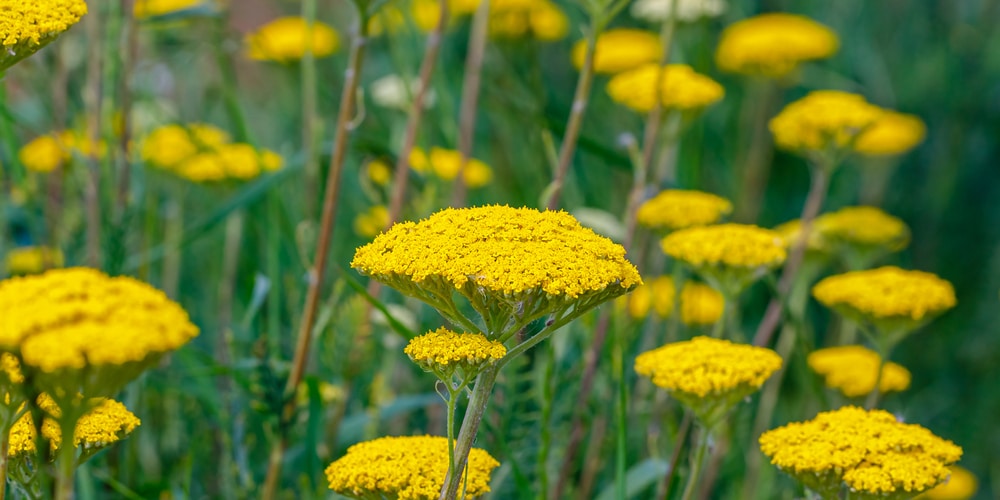There is something about a Yarrow flower that just commands attention. Whether it’s growing along the side of the road or framing a garden gate, this plant makes a statement.
The feathery leaves and sturdy stems create an air of nobility, while the flowers light up any space with their sunny disposition. If you’re looking for a versatile perennial that will add pizzazz to your garden, the Achillea filipendulina, also known as Parker’s variety or fern-leaf yarrow, is the perfect plant for you.
Native to Europe and Asia, the Achillea Parkers has been a favorite of gardeners for centuries. Originally used as a medicinal herb, this plant has since been cultivated for its beautiful flowers. The Achillea Parkers is a member of the Asteraceae family, which also includes daisies and sunflowers.
Achillea parkers is often famous for its use as borders, mass plantings, and cut flowers. It is a very drought-tolerant plant once it has become established.
| Botanical Name | Achillea Filipendulina |
| Common Name | Fern-Leaf Yarrow, Parker’s Variety |
| Plant Type | Perennial |
| Flower Color | Showy golden yellow blooms |
| Size When Mature | 36 – 48 inches tall, 24 – 36 inches wide |
| Bloom Time | Early summer to early fall |
| Sun Requirements | Full Sun, tolerates partial shade |
| USDA Hardiness Zones | 3 – 8 |
| Soil PH Range | 5.5 – 6.8 |
| Soil Type | Loamy, well-drained, acidic |
| Water Needs | Low to medium |
| Native Area | Central Asia |
What You Need to Know About Achillea Parkers
Achillea filipendulina ‘Parker’s Variety’ is a herbaceous perennial that grows in a clump. It has fine, fern-like leaves arranged in a rosette around the stem. Its beautiful green leaves with a silvery sheen make a lovely addition to any garden. The plant can grow up to 3 feet tall and 2 feet wide.
The flowers of the Achillea Parker’s are its most striking feature. They are large, flat disks arranged in clusters at the end of each stem. The flowers are a beautiful shade of yellow with a hint of orange in the center. They bloom from early summer to fall and are known to be a pollinator’s favorite, with blooms lasting up to 2 weeks.
This plant is very easy to care for and is an excellent choice for beginner gardeners. It is drought, deer, and rabbit-tolerant and can even handle poor, dry soil. Moreover, this lovely and stunning plant is quite versatile and can be used in various ways in your garden.
How to Care for Achillea Parkers
Here’s everything you need to know about growing and caring for a thriving Achillea Parkers in your garden
Light
While the Achillea parkers is commonly used as borders in the garden, they are also often grown in containers. If you are growing your plant in a pot, make sure to choose one that is large enough to accommodate the plant’s mature size. It is best to plant Achillea parkers in an area that receives full sun.
This sun-loving plant will do best in an area that receives at least 6 hours of sunlight per day. However, it can also tolerate some light shade, especially in hot summer climates.
Water and Soil Needs
The Achillea Parker’s variety grows best in well-drained, sandy soil with a PH of 5.5 to 6.8. Surprisingly, this plant can survive even in poor soil conditions, given that it is not waterlogged. It is best to water your plant at the base rather than from above to avoid wetting the foliage.
It is important to let the soil dry out between watering. This plant is drought-tolerant and can survive long periods without water, making it a great choice for those who are forgetful or have busy schedules.
With a low to medium need for water, this plant is a great choice for those who are looking for a drought-tolerant option.
Temperature Requirements
The Achillea Parkers is a plant that can survive in USDA climate zones 3-8. Temperatures in this zone range from -40 degrees Fahrenheit to 100 degrees Fahrenheit.
This plant is quite resilient and can survive both hot and cold weather conditions. However, it is best to protect your plant from extreme temperatures, whether it be heatwaves or frost, for it to thrive and grow to its full potential.
Fertilizer
Although the Achillea parkers is a plant that can grow in poor soil conditions, it will still benefit from being fertilized. It is best to fertilize your plant in early spring before it blooms. A slow-release fertilizer or compost is ideal for this plant.
Common Diseases
As a resilient plant that can tolerate drought and poor soil conditions, the Achillea parkers is quite resistant to disease. However, there are still a few diseases that can affect your plant.
Powdery mildew is a common disease that can affect many different types of plants, including the Achillea Parker’s. This disease appears as a white powder on the plant’s leaves and can eventually cause the leaves to turn yellow and fall off. Other symptoms of powdery mildew include stunted growth and distorted leaves.
Additionally, it may also be affected by rust, which is a disease that causes orange or brown spots on the leaves of the plant. Rust can also cause the leaves to fall off and may stunt the plant’s growth.
These diseases are more likely to occur in humid or wet conditions, so keep an eye out for them if the weather has been particularly rainy or humid.
Achillea Parkers Propagation
The Achillea filipendulina is a beautiful yellow flower that blooms in the summertime. It’s easy to propagate from seed, and there are a few different methods that can be used.
One method is to direct sow the seeds in late fall or early spring. Another option is to start the seeds indoors about 6-8 weeks before the last frost date. Once the seedlings have germinated, transplant them into individual pots.
Finally, the Achillea filipendulina can also be propagated by division, which is by far the easiest method. This can be done in early spring or fall, and all you need to do is dig up the plant and carefully divide it into sections, ensuring each section has a few roots attached.
It is recommended to propagate the Achillea Parkers variety every 3-4 years to ensure that it continues to bloom beautifully.
Related article: Achillea Paprika


